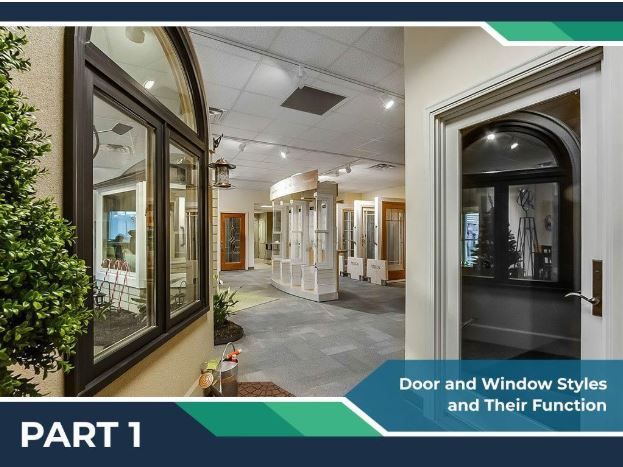

When choosing a door or window style for your replacement project, it pays to weigh its benefits. Consider how a certain style can affect functionality vis-a-vis what your home’ requirements, and decide from there. There are many window and door options available today, each of them offering distinctive features that make them a worthy investment. Here’s an overview of each one:
Pro-Tip: Have double-hung or casement windows installed in areas that use a significant amount of water, such as your bathroom or laundry area. With their ventilating action, these units can prevent excessive indoor moisture, while keeping these rooms fresh and odor-free.
Patio doors come in hinged French or sliding glass options. The former swings outward to the outdoor living space, creating a wide opening that allows for smoother foot traffic (very handy for entertaining!). The latter offers the same, with the added benefit of saving space. Sliding glass patio doors fit neatly to the side so they don’t interrupt furniture placement. Both hinged French and sliding glass patio doors help create a stronger connection between your indoor and outdoor spaces.
One of the most important steps in choosing your new windows and patio doors is to match them with your home’s architectural style. This way, they can further enhance the exterior but staying true to its original design elements. Some windows–double-hung ones, for instance–are versatile enough to complement both traditional and contemporary home styles, but most work better with a specific architectural styles. Here are a few examples:
A minimalist appearance, smooth and clean lines, design elements in steel, glass and stone–these are some of the features you’ll find in a Modern-Contemporary home. This architecture favors open, spacious rooms with considerable access to natural light. That’s why picture and sliding windows are a staple for this home style. Both windows have thin frames and a large glass area, helping better connect the home’s interior with the outdoors. Because this same glass area lets in a large amount of natural light, picture and sliding units help keep your home brighter for longer during the day
With their unique design, bay and bow windows are a perfect match for Queen Anne homes. These units highlight the architecture’s asymmetrical details, brooding look and bold color schemes. The curved design of bay and bow allows natural light to come in from different angles, maximizing your home’s daylighting. To further add to the aesthetics of your Queen Anne home, make sure the bay or bow units’ trim color goes well with the current exterior palette.
Steep, multi-gabled rooflines, decorative half-timbering and elegant entryways characterize a French Tudor home. It features tall, narrow multi-paned windows in groups of up to four. Casement units are the traditional choice for this architecture. They provide fresher, cooler air and an extended view of the outdoors. Casement windows also grace Spanish-Mission homes, which are characterized by smooth, flat wall surfaces, red tile roofing, arched entryways and neutral exterior color schemes.
What about patio door styles? Hinged French doors are the typical option for traditional homes such as Colonial, Craftsman or Cape Cod because of their classic look and elegant detailing. Sliding glass patio doors, on the other hand, are common in Modern, Contemporary or Industrial homes. Extensive customization options offered by premier window companies, however, allow you to design your patio door in such a way that it’s never limited to just one home style. A sliding glass door for your Craftsman home? No problem! Be creative and enjoy the design possibilities offered by this home improvement.
Good looks and function are priorities when choosing new windows or patio doors, but do take into account their energy performance, as well. Did you know that your choice of window style alone can already make a big difference in your home’s comfort and energy efficiency? Check out these examples:
Which patio door style is energy-efficient? Hinged French doors might be better at energy-savings as they create an airtight seal when closed. When it comes to cooling your home, however, both options do well, as their wide openings let in plenty of breezes.
Pro-Tip. Your choice of window style can help contribute to a more comfortable, energy-efficient home; you can even further enhance performance with the right framing material and glass. For many homeowners, the best combination is a composite frame with low-emissivity (Low-E) glass. Composite windows offer both durability and energy performance: they combine the best features of other framing materials, including wood’s strength and insulating properties, with vinyl’s low maintenance requirements. Composite windows effectively resist corrosion, chipping and other types of damage, while keeping an airtight seal that prevents energy loss.
Low-E glass supports the insulating value of composite windows by helping reduce heat transfer. This results in a better thermal comfort, minus the high energy costs. There are even Low-E glass options that are treated with UV-blocking technology to help prevent sun damage to your interiors. Together, composite frames and Low-E glass allow for windows that offer exceptional energy performance.
Window and door replacement doesn’t have to be a taxing process. You can easily make the most of your home improvement project by choosing style that best fits your needs.